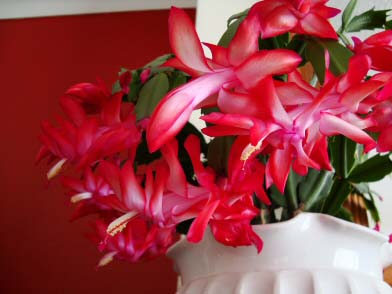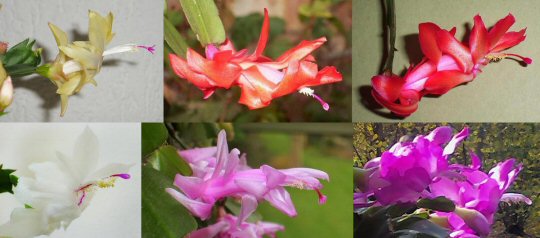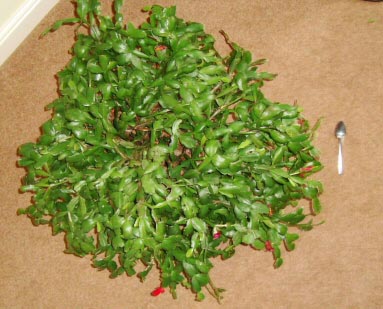





Let's just take a moment to look at the scientific botanical name of the Christmas Cactus - Schlumbergera Buckleyi. No wonder almost every one who comes across this houseplant just calls it the "Christmas Cactus" or "Thanksgiving Cactus".  And if you have come across this plant, or its cousin the Easter Cactus (with an equally difficult to say scientific name we might add) in flower, you won't forget either of them in a hurry. With their attention grabbing large and vibrant, but elegant, flowers they leave a lasting impression.
And if you have come across this plant, or its cousin the Easter Cactus (with an equally difficult to say scientific name we might add) in flower, you won't forget either of them in a hurry. With their attention grabbing large and vibrant, but elegant, flowers they leave a lasting impression.
This houseplant comes into it's own at Christmas which is when the plant blooms and the reason for its common name, however for most of the year the Christmas Cactus looks quite plain. Although these plants are forest rather than desert cacti, it's easy to see similar elements of their distant sun loving cousins in their design. The leaves are thick chunky segments all in a long chain radiating from the plant's center which, like all succulents, have the ability to store water in times of drought.
There aren't a great many varieties available, in fact you're only likely to find these plants labeled as Schlumbergera truncata or Schlumbergera buckleyi. The major difference between the two being the shape of the leaves, and even that's only a subtle difference at best. That said the quantity of different flower colours is quite extreme and the number of available cultivars is ever increasing. There will surely be a complementary Christmas Cactus out there for you, no matter the colour scheme of your home.

We listed the plant in the intermediate difficulty section not because it's difficult to grow, but getting the flowers to return on mass each year needs a little finesse. Don't be intimidated though, we will provide the secrets of success and get you enjoying the sometimes elusive flowers for years to come.
Unlike desert cacti, the Christmas Cactus grows natively in shady forests. This means direct harsh sunlight needs to be avoided. They need a well lit spot, although they will take darker locations as long as they can be given brighter light for at least a few months of the year.
Unusually for a cacti - direct harsh sunlight needs to be avoided
Like all cacti they can store water inside their thick fleshy leaves, and live off this in emergencies. However if you want a thriving specimen you will need to water as you would a normal houseplant, i.e. when the soil becomes dry.
Misting the leaves a few times a month is recommended if the plant has been positioned in a dry environment (think that naturally they come from shady, dank and moisture rich forests). Do not mist if your Christmas Cactus is in flower or you risk making them go soggy and rot away.
Feed during the growing season about once a month. To encourage a large number of blooms to form if possible feed with a tomato feed which should be high in Potassium. If this isn't practical, an all purpose houseplant fertiliser will be fine.
The average temperatures in most homes is perfect. The plant must rest after it has flowered, and this needs to be slightly cooler, 7°C - 15 °C / 45°F - 59°F. An unheated room would usually be ideal.
The Christmas Cactus grows slowly and it takes quite a while to become pot bound. Repot after flowering if needed, but you probably won't have to do it more than once every three years or so.
In Spring or Summer cut off part of one of the stems with 2 or 3 "segments" attached. Wait a day for the cut to dry over before inserting it into a pot with compost. You can use a rooting hormone if you prefer but cuttings normally take really easily on their own. Don't go crazy with the watering and aim to keep the compost only slightly moist (too much and the cutting will rot).
As mentioned the Christmas Cactus is a slow growing houseplant.
There is no denying that the Christmas Cactus is a slow growing plant, but over many years it can become quite spread, and heavy! (See picture on right, this one is now around 25 years old. Shown next to a teaspoon for scale).
The secret to masses of blooms is to move it outdoors.
When in bloom this plant is truly spectacular! You may get one or two flowers if you leave it in the same place all year round, however the simple secret to masses of blooms is to move it - outside.
At some point between June through to August put the plant outside in a shady protected location. In short exposure to the elements outdoors hardens up the the new growth that will start to form from Spring. If kept indoors the new growth stays quite soft and flowers rarely form, exposure to the great outdoors over a couple of months hardens the plant up.
Buds appear on the very end of each stem after a few months of being outside, but it will take another month or so before they are fully developed. Ideally when the largest bud looks close to opening, bring the plant indoors to its flowering location and do not move it again until flowering has finished. This is because they dislike being moved about when in flower and doing so runs the risk of bud blast.
The plant should be brought inside when buds are forming or outdoor night time temperatures approach 7°C / 45°F, which ever comes first. (The Easter Cactus needs to come in when it starts getting cold outside regardless, because it won't show buds until early the following year).
When you put the plant outside for the Summer guard against slugs and snails, which will take random bites out of the segments.
Copyright © www.100flowers.win Botanic Garden All Rights Reserved